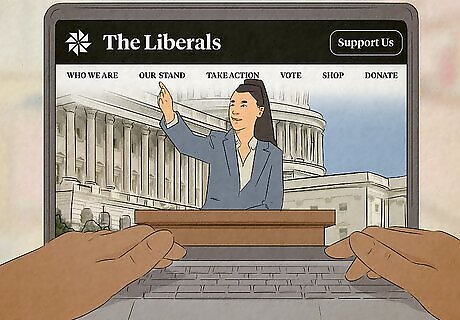
views
Organizing Supporters

Hold meetings to generate interest in forming a party. At every stage of creating and maintaining a political party, you’ll need lots of enthusiastic involvement. Let others know that you are interested in starting a new party, and ask them to get involved. You could try starting out by holding a meeting with people you already know in a community center or even at your home. If there’s interest in creating a new party, tell them to spread the word to people they know. Hold a second, larger meeting inviting these people, too. Ensure attendance at all meetings. When officially filing your party, you’ll typically need to prove that you’ve been holding meetings. It’s never too early to start soliciting donations. At the early stages, you can start a crowdfunding campaign. Later, you can have your financial team set up a more formal donation process.

Rally around potential candidates. You might want to start a political party to draw attention to a great candidate for office, and to help them get elected. If you have a charismatic candidate you would like to promote, ask them to attend your meetings. They can give speeches, take promotional photos, greet constituents, and generally increase the buzz about the formation of your new party.

Write a platform describing your party’s basic principles. You can start by having discussions at your meetings about what your party wants to emphasize. Generate a list of your principles, and designate a member or a committee to draw these up. Share them with the whole group, make any necessary changes, and vote to officially adopt the platform. Address things like: What aspects of political, social, or economic life would your party like to improve? What would your party want to accomplish if elected to office? What sets your party apart from others? Why would voters want to support your party’s candidates?

Establish rules and regulations for your party. A political party is a complex organization, and hopefully one that will grow over time. To keep things manageable, you’ll need to establish another committee to write bylaws. When they’re drafted, share them with everyone before voting to approve them. You’ll often also need to share these when officially filing. Bylaws will discuss things like: Who is the party’s leadership? How will they be elected? What committees will be formed? How do members vote on important issues? How will candidates be chosen? How will disagreements be handled? When will meetings be held, and what form will they take?

Work out the financial aspects. It takes money to organize a political party and promote candidates for elections. Your party will need rules for how money will come in, who will oversee it, and how it will be used. When officially filing your party, you will probably need to provide a statement of your financial scheme and an explanation of your accounting, so it’s a good idea to write these early. Consider: How will donations be generated? What account or accounts will money be held in? Which committee will be in charge of finances? Who will provide your accounting services? What guidelines do you want to set for things like how money can be spent on election campaigns? What procedures will you have for ensuring financial transparency? How will you handle any financial disagreements or investigations?
Branding Your Party

Give your party a distinctive name. A political party will be known everywhere by its name, so give this some thought. You’ll need to select a name that isn’t already taken by another party, and isn’t so similar to another one that the public will get confused. Check with your local electoral commission for a list of currently registered political parties. Select a name that captures your party’s core values. Try to keep the name short -- no more than a couple of words. That way, it will be memorable and easily identifiable.

Create a logo identifying your party. Logos are used everywhere to advertise and identify political parties. They’re typically also required when officially registering a party. Choose one that’s not too complex, but is distinctive. For example, if your party emphasizes conservative principles, you could select a logo that contains a traditional symbol of your area. If you want to brand your party as an innovator, consider a logo that depicts a modern, contemporary symbol while using traditional colors.

Establish a website with your own domain. It’s vital for a political party to have a website that the public can visit for more information. Purchase a domain name that is closely related to your party’s name. Put the website’s address on promotional materials, and distribute these at meetings. Your website’s content could include things like: A copy of your party’s manifesto and core beliefs. Biographies and statements from party leaders. Information about upcoming events and elections. Pages for any candidates that are running in elections. A link for information on how to donate. Clear and specific calls to action.

Utilize social media to promote your party. Get the word out about any events that are hosted by your political party. You can also create and share promotional videos and images to let the public know what your party is all about. Make sure to post regularly -- you can also share news content and other materials that are relevant to your party’s interests. Social media services are vital to generating and maintaining interest in your party. Get out there on Facebook, Twitter, Instagram, Youtube, and any other major social media sites. Designate a social media team to oversee this aspect of your party’s activities.
Party Registration

Collect signatures from supporters. To qualify as a political party, you’ll typically need a certain number of signatures. This may simply be a hard number, like 1000, or it may be a certain percentage of voters registered in your area, like 5 percent. Pass around a paper or online form that announces it as a petition to create a political party. Have supporters sign. If you already have enough members in your party, just collect their signatures. Otherwise, get out there on the street, describe your party to passersby, and ask them to sign in support.

Meet any specific eligibility requirements. These can vary widely depending on the area you live in. In some cases, for instance, you might need to do things like: Prove that you have spent more than $1,000 on election campaigns in a year,. Show that you have received contributions. Have a current politician declare membership. Reach a threshold number of official members.

File at the right time. In some cases, you can only register a political party at certain times of the year. For instance, you may not be able to register a new political party shortly before an election. If you aren’t sure of the rules in your area, check with your local electoral commission.

Submit official filing paperwork. You’ll need to contact the electoral commission in your area to determine what paperwork you need to file. Typically, it will involve an official form, and copies of supporting documents like a statement of organization, contact information for officers, necessary signatures, and a financial statement. There may also be a filing fee. Once you’re officially registered, you should be able to officially have candidates placed on ballots for elections.
















Comments
0 comment